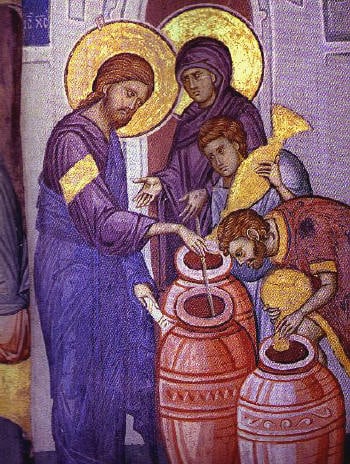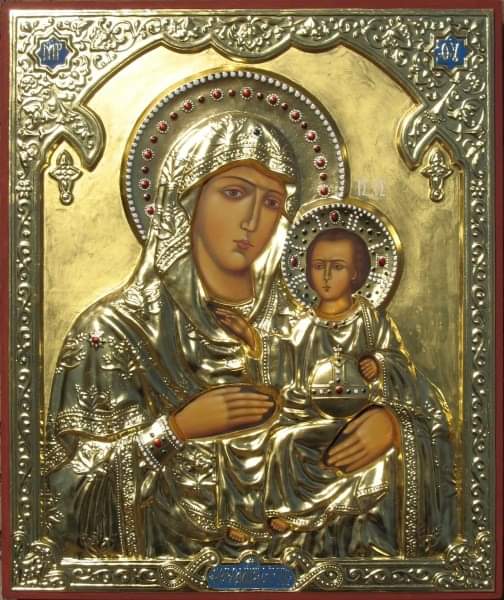By prof. A. P. Lopukhin
John, chapter 2. 1 – 12. The miracle at the wedding in Cana of Galilee. 13 – 25. Christ in Jerusalem. The cleansing of the temple.
2:1. On the third day there was a wedding in Cana of Galilee, and the mother of Jesus was there.
2:2. Jesus and His disciples were also invited to the wedding.
“On the third day.” It was the third day after the day Christ called Philip (John 1:43). That day, Christ was already in Cana of Galilee, where he came, probably because His pure mother had gone there before Him – to a wedding in a familiar family. We can assume that at first He went to Nazareth, where He lived with His mother, and then, not finding her, He went with the disciples to Cana. Here both He and His disciples, probably all five of them, were also invited to the wedding. But where was Cana? Only one Cana in Galilee is known – a small town an hour and a half northeast of Nazareth. Robinson’s suggestion that there was another Cana four hours from Nazareth to the north is not well founded.
2:3. And when the wine was finished, His mother said to Jesus: they have no wine.
2:4. Jesus says to her: what have you to do with Me, woman? My hour has not yet come.
2:5. His mother said to the servants: whatever he tells you, do.
“when the wine is finished.” Jewish wedding celebrations lasted up to seven days. (Gen. 29:27; Judg. 14:12-15). Therefore, at the time of the arrival of Christ with His disciples, when several days had already passed in festivities, there was a shortage of wine – apparently, the hosts were not rich people. The Blessed Virgin had probably already heard from Christ’s disciples about the things that John the Baptist had said about her Son, and about the promise of miracles that He had given His disciples two days before. Therefore, she considered it possible to turn to Christ, pointing out to Him the difficult situation of the housewives. Perhaps she also had in mind the fact that the disciples of Christ, with their presence at the celebration, had disturbed the calculations of the hosts. However, whatever the case may be, there is no doubt that she expected a miracle from Christ (St. John Chrysostom, Blessed Theophylact).
“Woman, what have you to do with Me?” Christ answered this request of His mother with the following words. “What have you to do with Me, woman? My hour has not yet come.” The first half of the reply seems to contain some reproach to the Blessed Virgin for wanting to induce Him to begin working miracles. Some see a tone of reproach also in the fact that Christ calls her here simply “wife” and not “mother”. And indeed, from Christ’s next words about His “hour,” it can no doubt be inferred that by His question He meant to tell her that henceforth she must abandon her usual earthly motherly view of Him, by virtue of which she thought, that it is within its right to demand from Christ as a mother from a son.
Earthly kinship, however close it may have been, was not decisive for His divine activity. As at His first appearance in the temple, so now, at the first appearance of His glory, the finger that pointed to His hour did not belong to His mother, but only to His heavenly Father” (Edersheim). Yet Christ’s question contains no reproach in our sense of the word. Here Christ is only explaining to His mother what their relationship should be in the future. And the word “woman” (γύναι) does not contain in itself anything offensive, applied to the mother, that is, in the address of a son to a mother. We see that Christ calls His mother in the same way, when before His death, looking at her with love, He appointed John to be her protector in the future (John 19:26). And finally, in the second half of the answer: “My hour has not yet come,” we cannot at all see a refusal of the mother’s request. Christ says only that the time for a miracle has not yet come. From this it appears that He wanted to fulfill His mother’s request, but only at the time appointed by His heavenly Father. And the Most Holy Virgin herself understood the words of Christ in this sense, as is evident from the fact that she told the servants to carry out everything that her Son ordered them to do.
2:6. There were six stone jars there, set for washing according to the Jewish custom, holding two or three measures each.
2:7. Jesus tells them: fill the jars with water. And they filled them to the brim.
2:8. Then he tells them: pour it now and take it to the old man. And they took it.
According to the Jewish custom, the hands and dishes were to be washed at a meal (cf. Matt. 15:2; 23:25). Therefore, a large amount of water was prepared for the wedding table. From this water, Christ ordered the servants to fill six stone jars, with a volume of two or three meras (by meras here, probably, is meant the ordinary measure of liquids – bath, which was equal to approximately four buckets). Such vessels, holding up to ten buckets of water, stood in the yard, not in the house. So the six vessels contained up to 60 buckets of water, which Christ turned into wine.
The miracle was performed on such a scale that someone would later explain it in a natural way. But why did Christ not make wine without water? He did so “so that those who drew water themselves could witness the miracle and it would not look ghostly at all” (St. John Chrysostom).
2:9. And when the old matchmaker had taken a bite of the water that had turned into wine (and he did not know where the wine came from, but the servants who had brought the water did), he called the bridegroom
2:10. and said to him: every man puts first the good wine, and when they are drunk, then the lower, and you have kept the good wine until now.
“the old matchmaker” (in the original, ὁ ἀρχιτρίκλινος – the main person responsible for the table in the triclinium. The triclinium is the dining room in Roman architecture, note pr.).
The master of the feast tasted the wine and found it very good, which he told the bridegroom. This testimony confirms that the water in the vessels was indeed turned into wine. Indeed, there could not have been any self-suggestion on the part of the steward, for he was evidently ignorant of what the servants had done at Christ’s command. Moreover, he certainly did not indulge in immoderate use of wine, and was therefore perfectly capable of determining the actual quality of the wine served to him by the servants. In this way, Christ, ordering wine to be brought to the steward, wanted to remove any reason for doubt as to whether there really was wine in the vessels.
“when they get drunk” (ὅταν μεθυσθῶσι). After all, the guests were also sufficiently able to appreciate the wine served to them. Christ and the Blessed Virgin would not have stayed in a house where there were drunken people, and the hosts, as we said, were not rich people and did not have too much wine, so that they would get “drunk”… The expression of the steward: “when the drunkard” means that sometimes inhospitable hosts serve their guests bad wine; this happens when the guests are no longer able to appreciate the taste of the wine. But the steward does not say that in this case the host had such a consideration and the guests were drunk.
The evangelist interrupts the account of this conversation with the bridegroom, and mentions not a word of the impression which the miracle made on all the guests. For him it was important insofar as it served to strengthen the faith of Christ’s disciples.
2:11. Thus Jesus began His miracles in Cana of Galilee and manifested His glory; and His disciples believed in Him.
“Thus Jesus began the miracles…” According to the most authoritative codices, this place should have the following translation: “this (ταύτην) Jesus did as the beginning (ἀρχήν) of the signs (τ. στηντες)”. The evangelist sees Christ’s miracles as signs attesting to His divine dignity and His messianic vocation. In this sense, the apostle Paul also wrote about himself to the Corinthians: “the marks (more precisely, the signs) of an apostle (in me) were shown among you in all patience, in signs, wonders and powers” (2 Cor. 12:12 ). Although Christ three days before had given His disciples proof of His wondrous knowledge (John 1:42-48), but then He revealed Himself only as a prophet, and such there were before Him. While the miracle in Cana was the first of His works, about which He Himself said that no one had done such things before Him (John 15:24).
“and manifested His glory.” The meaning of this sign and its importance is indicated in the words: “and manifested His glory.” What kind of glory are we talking about here? No other glory can be understood here than the divine glory of the incarnate Logos, which the apostles contemplated (John 1:14). And in the further words of the evangelist: “and His disciples believed in Him” the action of this manifestation of the glory of the incarnate Logos is directly indicated. The disciples of Christ gradually came to faith in Him. At first their faith was in its infancy – that was while they were with John the Baptist. This faith was afterwards strengthened as they drew near to Christ (John 1:50), and after the manifestation of His glory at the wedding at Cana they reached such great faith that the evangelist finds it possible to say of them that they “believed” in Christ, that is, they have convinced themselves that He is the Messiah, and a Messiah at that, not only in the limited sense that the Jews expected, but also a being standing higher than the ordinary messengers of God.
Perhaps the evangelist makes the remark that the disciples “believed in view of the impression made upon them by the presence of Christ at the merry wedding feast. Being brought up in the strict school of John the Baptist, who taught them to fast (Matt. 9:14), they may have been perplexed by this regard for the joys of human life which their new Master displayed, and himself took part in the celebration and took them there. But now that Christ had miraculously confirmed His right to act differently from John, all doubts of the disciples should have disappeared and their faith strengthened. And the impression of the miracle at Cana produced on the disciples was especially strong because their previous teacher had not performed a single miracle (John 10:41).
2:12. After that He went down to Capernaum Himself, and His mother, and His brothers, and His disciples; and they stayed there not many days.
After the miracle in Cana, Christ went to Capernaum with His mother, His brothers (for the brothers of Christ – see the interpretation of Matt. 1:25) and the disciples. As to the reason why Christ went to Capernaum, we judge from the circumstance that three of the five disciples of Christ lived in that city, namely Peter, Andrew and John (Mark 1:19, 21, 29). They could continue their fishing activities here without breaking communion with Christ. Perhaps the two other disciples, Philip and Nathanael, also found work there. But what did the coming to Capernaum of Christ’s mother and brothers mean? The most likely assumption is that the entire family of Jesus Christ decided to leave Nazareth. And indeed, from the synoptic Gospels it appears that Capernaum soon became the permanent residence of Christ and His family (Matt. 9:1; Mark 2:1; Matt. 12:46). And in Nazareth only the sisters of Christ remained, apparently already married (Matt. 13:56).
“Capernaum” – see The interpretation to Matt. 4:13.
“He came” – more precisely: he came down. The road from Cana to Capernaum went downhill.
2:13. The Jewish Passover was approaching, and Jesus went up to Jerusalem
In Capernaum Christ obviously did not draw attention to Himself. He had to begin His public activity in the capital of Judaism, namely in the temple, according to the prophecy of Malachi: “Behold, I am sending My Angel, and he will prepare the way before Me, and suddenly the Lord, whom you you seek, and the Angel of the covenant, whom you desire; behold, He is coming, says the Lord of hosts” (Mal. 3:1).
On the occasion of the approach of the Passover, Christ went or, more precisely, ascended (άνέβη) to Jerusalem, which to every Israelite seemed to stand on the highest point of Palestine (cf. Matt. 20:17). His disciples were with Him this time (John 2:17), and perhaps His mother and brothers.
2:14. and he found in the temple sellers of oxen, sheep, and doves, and money-changers sitting.
According to the custom of worshipers, immediately after arriving in Jerusalem, Christ visited the temple. Here, mostly in the outer court, which served as a place where the Gentiles could pray, and partly in the temple galleries, He found people selling sacrificial animals to the worshipers, or were busy exchanging money, for at the Passover every a Jew was obliged to pay a temple tax (didrachm, see Commentary on Matt. 17:24) and necessarily with the ancient Jewish coin that was offered to the worshipers by the money changers. The coin to be brought into the temple treasury was half a shekel (which corresponds to eight grams of silver).
2:15. And making a scourge of wood, he drove out of the temple all, also the sheep and the oxen; and he spilled the changers’ money and overturned their tables.
This trade and exchange of money disturbed the prayerful mood of those who came to pray. Especially hard was this for those pious pagans who were not allowed to enter the inner court where the Israelites prayed, and who had to listen to the bleating and the squealing of the animals and the cries of the merchants and buyers (merchants, must it should be noted, they demanded for the animals often three times more expensive, and the buyers, of course, raised a dispute with them). Christ could not tolerate such an insult to the temple. He made a whip from the pieces of rope lying around the animals and drove the merchants and their cattle out of the temple yard. Still more cruelly did He deal with the money-changers, scattering their money and overturning their tables.
2:16 a.m. and to the dove sellers he said: take this from here and do not make My Father’s house a house of commerce.
Christ dealt more gently with the dove sellers, commanding them to remove the cages with the birds (ταύτα = this, not ταύτας = “they”, i.e. the pigeons). To these merchants He explains why He interceded for the temple. He told them: “do not make My Father’s house a house of commerce”. Christ thought it his duty to plead for the honor of His Father’s house, evidently because He considered Himself the only true Son of God…, the only Son Who could dispose of His Father’s house.
2:17. Then His disciples remembered that it was written: “jealousy for Your house has eaten Me up.”
None of the merchants and money changers protested against Christ’s actions. It is possible that some of them perceived Him as a zealot – one of those zealots who, after the death of their leader Judas the Galilean, remained faithful to his motto: to restore the kingdom of God with the sword (Josephus Flavius. The Jewish War. 2:8, 1) . Others, however, probably realized that they had been doing wrong until now, rushing into the temple with their wares and organizing a sort of market here. And as for Christ’s disciples, they perceived in the action of Christ, in His zeal for the house of God – a fulfillment of the prophetic words of the psalmist, who, saying that he was consumed by zeal for the house of God, prefigured with what zeal for the glory of God the Messiah would performs His ministry. But since in the 68th psalm quoted by the evangelist it is about the sufferings that the psalmist endured because of his devotion to Yahweh (Ps. 68:10), the disciples of Christ, remembering the excerpt from the psalm quoted, should at the same time have thought about the danger to which their Master exposed himself, declaring himself so boldly against the abuses which the priests apparently patronized. These priests, of course, were not the ordinary priests who came at the appointed time to serve in the temple, but the permanent officials from among the priests – leaders of the priesthood who lived in Jerusalem (and especially the high priestly family), and who had to constantly to derive benefits. From this trade, the merchants had to pay a certain percentage of their profit to the temple officials. And from the Talmud we see that the market at the temple belonged to the sons of the high priest Anna.
2:18. And the Jews answered and said to Him: by what sign will You prove to us that You have the authority to act thus?
The Jews, that is, the leaders of the Jewish people (cf. John 1:19), the priests of the highest rank (the so-called sagans), immediately began to demand from Christ, who probably seemed to them a zealot (cf. Matt. 12:4), to give them a sign as a proof of His right to act as a reprover of disorders in the temple. They, of course, could not deny that their position of leadership was only temporary, that the “faithful prophet” should appear, before whose coming Simon Maccabee and his descendants had assumed the government of the Jewish people (1 Maccabees 14: 41; 4:46; 9:27). But, of course, this “faithful prophet” had to prove his divine messengership with something. It was in this sense that they put the question to Christ. Let Christ perform a miracle! But they did not dare to capture Him, because the people were also indignant at the desecration of the temple, which the priests allowed out of favor.
2:19. Jesus answered them and said: destroy this temple, and in three days I will raise it up.
The Jews demanded of Christ a miracle to prove that he had the right to act as Yahweh’s authorized messenger, and Christ was willing to give them such a miracle or sign. But Christ gave His answer a somewhat mysterious form, so that His word remained misunderstood not only by the Jews, but even by the disciples (verse 22). By saying “destroy this temple” Christ seemed to have in mind the Jewish temple, which is indicated by the addition “that” (τοῦτον). If, in saying these words, Christ had pointed to His body, then there would have been no misunderstanding: all would have understood that Christ was foretelling His violent death. Thus, by “temple” (ό ναός opposed to the word το ίερόν, which means all the rooms of the temple and the court itself, cf. John 2:14-15) could be understood above all the temple that was visible to all. But on the other hand, the Jews could not fail to see that they could not limit themselves to such an understanding of Christ’s words. After all, Christ told them that it was they who would destroy the temple, and they, of course, could not even imagine raising a hand against their national shrine. And then, Christ immediately presents Himself as the restorer of this temple destroyed by the Jews, apparently going against the will of the destroying Jews themselves. There was some misunderstanding here again!
But still, if the Jews and Christ’s disciples had paid more attention to Christ’s words, perhaps they would have understood them despite all their apparent mystery. At least they would have asked what Christ meant to tell them by this apparently figurative statement; but they deliberately dwell only on the plain literal sense of His words, endeavoring to show all their groundlessness. Meanwhile, as was explained to the disciples of Christ after His resurrection, Christ actually spoke of the temple in a double sense: both of this stone temple of Herod, and of His body, which also represented the temple of God. “You – as Christ said to the Jews – will destroy your temple by destroying the temple of My body. By killing Me as your adversary, you will incur God’s judgment and God will hand over your temple to destruction by the enemies. And along with the destruction of the temple, the worship must also cease and your church (the Jewish religion with its temple, b.r.) must end its existence. But I will raise up My body in three days, and at the same time I will create a new temple, as well as a new worship, which will not be limited by those boundaries in which it existed before.”
2:20. And the Jews said: this temple was built for forty-six years, so will You raise it in three days?
“in three days.” Christ’s words about the miracle He could perform in three days seemed ridiculous to the Jews. They remarked with derision that Herod’s temple had taken forty-six years to build—how could Christ rebuild it, if it was destroyed, in three days, that is, as they probably understood the expression “in three days,” as possible -a short time? (cf. 1 Chron. 21:12); Luke 13:32).
“is built”. By “building the temple” the Jews evidently meant the long work of erecting various temple buildings, which was not completed until 63 A.D., therefore, only seven years before its destruction.
2:21. However, He was talking about the temple of His body.
2:22. And when He rose from the dead, His disciples remembered that He had spoken this, and they believed the Scriptures and the word that Jesus had spoken.
Christ did not answer anything to the remark of the Jews: it was clear that they did not want to understand Him, and even more so – to accept Him. Christ’s disciples also did not question Him about the words He said, and Christ Himself did not need to explain to them at that moment. The purpose with which He appeared in the temple was accomplished: He announced His intention to begin His great messianic work and began it with the symbolic act of cleansing the temple. It was immediately revealed what the attitude of the leaders of the Jewish people would be towards Him. Thus He began His public ministry.
2:23. And when he was in Jerusalem at the feast of Passover, many, seeing the miracles that he did, believed in his name.
2:24. But Jesus Himself did not trust them, for He knew them all,
2:25. and there was no need for anyone to testify about the man, because Sam knew what was in the man.
“many . . . believed in His name.” Here the evangelist talks about the impression that Jesus Christ made with His first appearance in Jerusalem on the masses. Since on this occasion the Lord performed many signs or wonders (cf. verse 11) during the eight days of the Passover festival, and since He repeatedly acted as a teacher, as appears, for example, from the words of Nicodemus (John 3:2) and partly from the words of Christ Himself (John 3:11, 19), many believed in Him. If here John mentions only the “miracles” that brought many Jews to Christ, he testifies that for the majority the signs were indeed the decisive moment in their conversion to Christ. That is precisely why the apostle Paul said: “the Jews ask for omens” (1 Cor. 1:22). They believed “in His name”, that is, they saw in Him the promised Messiah and wanted to found a community with His name. But the Lord knew all these believers well and did not trust in the constancy of their faith. He also knew every person He met by virtue of His wondrous insight, examples of which He had already given His disciples recently (John 1:42 – 50). Therefore, the number of Christ’s disciples during these eight days of the feast did not increase.
Modern New Testament criticism suggests that in the second half of the chapter under consideration, John tells about the same event that, according to the synoptics, happened at the last Passover – the Passover of suffering. At the same time, some exegetes consider the chronological description of the synoptics to be more correct, doubting the possibility of such an event already in the first year of Christ’s public ministry. Others give preference to John, suggesting that the synoptics have placed the event in question not in the place where it should be (cf. the interpretation of Matt. 21:12-17, ff. and the parallel places). But all the doubts of the critic have no basis. First of all, there is nothing incredible that the Lord spoke as a rebuker of the disorders reigning in the temple – that center of the Jewish people, and at the very beginning of His public ministry. He had to speak boldly in the most central place of Judaism – in the Jerusalem temple, if he wanted to declare Himself as the messenger of God. Even the prophet Malachi foretells the coming of the Messiah by saying that He will appear precisely in the temple (Mal. 3:1) and, as can be concluded from the context of the word (see the following verses in the same chapter of the book of Malachi), again in the temple he will execute his judgment on the Jews who are proud of their righteousness. Moreover, if the Lord had not then revealed Himself so clearly as the Messiah, He might have been doubted even by His disciples, to whom it must have seemed strange that their Master, who had already performed a great miracle at the wedding at Cana, should suddenly hide himself again from the attention of the people, remaining unnoticed in the quiet of Galilee.
They say: “but Christ could not immediately declare that He is the Messiah – He did this much later”. To this they add, that by acting as the reprover of the priests, Christ immediately placed himself in hostile relations with the priesthood, who could have immediately seized Him and put an end to His work. But this objection is not convincing either. Why should the priests seize Christ, when He demanded of the merchants only what was lawful, and they knew this very well? Moreover, Christ does not rebuke the priests directly. He drives out only the merchants, and the priests hypocritically might even thank Him for taking care of the honor of the temple…
Moreover, the conspiracy of the priests against Christ had been gradually taking shape, and they would not, of course, have dared, without a thorough discussion of the matter in the Sanhedrin, to take any decisive steps against Christ. In general, criticism has not been able to adduce convincing grounds to make us believe in the impossibility of repeating the event of the expulsion of the merchants from the temple. Conversely, there are some important differences between the Synoptics’ and John’s account of this event. Thus, according to John, the Jews asked Christ by what right He carried out the cleansing of the temple, and according to the Synoptics, the high priests and scribes did not ask such a question, but only reproached Him for accepting praise from children. Moreover, according to the Synoptics, the word of the Lord to the desecrators of the temple sounds much harsher than His word to John: there the Lord speaks as a Judge who came to punish the people who made the temple a den of robbers, and here He denounces the Jews only in that they turned the temple into a place of commerce.
Source in Russian: Explanatory Bible, or Commentaries on all the books of the Holy Scriptures of the Old and New Testaments: In 7 volumes / Ed. prof. A. P. Lopukhin. – Ed. 4th. – Moscow: Dar, 2009, 1232 pp.














